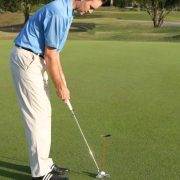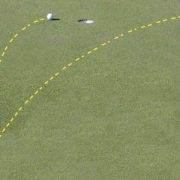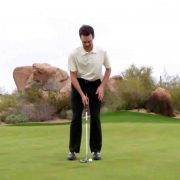Putting – Routine and Process for Consistency

Putting Routine
Putting practice strokes should be accurate rehearsals of the real thing.
1. Do your homework in reading the break
2. Establish your intended line of play
3. Make one or several realistic rehearsal strokes
4. Set the putter precisely behind the ball on the intended line. The direction factor is now taken care of and should leave your mind.
5. Take your stance comfortably bearing in mind your best rehearsal stroke.
6. Repeat your rehearsal stroke, letting the ball get in the way!
High Side vs Low Side
Regardless of whether you tend to miss putts on the right or the left, chances are very strong that you tend to miss your putts on the low side of the hole. The low side is the “downhill” side of the cup. For example, if a putt breaks from right to left, then the high side is on the right side and the low side is on the left. Conversely, if a putt turns to the right, then the high side is on the left side and the low side is now on the right side. 80 to 90% of all missed putts by amateurs are on the low side of the hole! This means that players are simply not accounting for nearly enough break when they are aiming their putts. Missing low leads to more 3-putts because the ball ends up a greater distance from the hole
. With the proper speed, a putt missing low will trickle downhill in a direction away from the hole. Meanwhile, a putt struck with the same speed on the high side, will trickle downhill directly toward the hole. Missing high leads to tap-ins, missing low leads to very long second putts.

Reading Greens
1. Slope in greens cause the ball to curve or break. The break that a putt experiences is a function of the ball’s speed. The faster the ball is rolling, the less break it will undergo on any given slope. With this in mind, putts are generally rolling their fastest immediately after impact, and their slowest around the hole as they decelerate to a stop. Putts break the most around the hole where the ball is rolling the slowest. Time permitting, take a look at the slope of the green around the hole, not just behind the ball. See whether one edge of the hole (left or right) is sitting higher than the other. This is where the majority of the break is going to happen.
2. When accounting for break, take off the blinders and bring in the big picture. Golf course architects do not build greens to retain water. Chances are very strong that water is logically designed to drain toward one or several practical sides of the putting surface. Take notice of the surrounding terrain: mountains, lakes, ponds, high areas, low areas, and the general lay of the land and take this into account when establishing your read.
3. When walking around the putting line, walk along the low side of the putt. From the side angle, you will be able to better judge if the putt is uphill or downhill. Also, from the low side, you will gain an important alternative perspective of the severity of the slope in the putt. For example, on a right to left breaking putt, you will have a far better vantage point from the left side of the putt (low side) than you would from the right side (high side).
4. Once we’ve done our homework and read the putt appropriately, we take care in precisely aiming the putter and setting up our body for the putt. This takes care of the direction factor completely. Put direction out of your mind and free yourself up to focus exclusively on distance control during your stroke. I believe it’s impossible to effectively think of both factors at the same time during your swing. Categorizing the two variables like this alleviates complication and hesitation in your mind.

Additional Putting Thoughts
Take an extra second or two to ensure that the putter face is aligned precisely on the line where you want the ball to start. Putter face alignment influences, almost entirely, the direction that your putt will go. As you take your grip and stance to the ball, it’s important to note that your putter is ordinarily the shortest club in your bag. You’ll need to stand very close to the ball, in a comfortable posture, with your arms and hands hanging softly beneath your shoulders. As you bow forward toward the ball, a good rule of thumb is to have your eyes over the ball. The ball is positioned slightly forward of center, encouraging impact on the way up just after the stroke has reached bottom. Be sure that your feet, knees, hips and shoulders are all parallel or perhaps slightly open to your starting line.
Once you have direction accounted for, trust that you are aligned correctly, and switch your mind over to exclusively distance control. The putting stroke itself is what we call a one lever motion, where we do not hinge or break our wrists in either direction at any point during the stroke. With very passive arms and hands, move the putter head more with your body and shoulders, allowing the length of the putting stroke to dictate the distance of the putt.
In your practice strokes, or rehearsal strokes, try to feel how much backswing you need in order to hit the putt the appropriate distance. Because we are standing so close to the ball, and a putter is so upright, the putting stroke naturally becomes more straight back and straight through, as opposed to around your body. Keep the club face square, or as I sometimes say, looking at the target, throughout the stroke. Maintain a quiet body and soft grip pressure for maximum feel and accuracy on the greens.
In summary, a putt is essentially a 2 dimensional shot consisting of only direction and distance. Do your homework and set up to your putt with absolute emphasis on direction. Be precise and ensure that your putter face is positioned squarely to your starting line. When you’re ready to take the club back, forget direction and focus exclusively on distance control. Organizing your thoughts in this way will help narrow your focus and yielding more consistent results. Bring the putter straight back and straight through, using your judgement and feel, taking an appropriate length backswing to satisfy the length of the putt.









